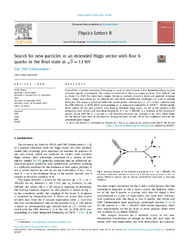Search for new particles in an extended Higgs sector with four b quarks in the final state at √s = 13 TeV
| dc.contributor.author | Tumasyan, A. | |
| dc.contributor.author | Işıldak, Bora | |
| dc.date.accessioned | 2023-09-12T12:00:54Z | |
| dc.date.available | 2023-09-12T12:00:54Z | |
| dc.date.issued | 2022-12-10 | |
| dc.identifier.issn | 0370-2693 | en_US |
| dc.identifier.uri | http://hdl.handle.net/10679/8801 | |
| dc.identifier.uri | https://www.sciencedirect.com/science/article/pii/S0370269322007006 | |
| dc.description.abstract | A search for a massive resonance X decaying to a pair of spin-0 bosons ϕ that themselves decay to pairs of bottom quarks, is presented. The analysis is restricted to the mass ranges mϕ from 25 to 100 GeV and mX from 1 to 3 TeV. For these mass ranges, the decay products of each ϕ boson are expected to merge into a single large-radius jet. Jet substructure and flavor identification techniques are used to identify these jets. The search is based on CERN LHC proton-proton collision data at s=13TeV, collected with the CMS detector in 2016–2018, corresponding to an integrated luminosity of 138fb−1. Model-specific limits, where the two new particles arise from an extended Higgs sector, are set on the product of the production cross section and branching fraction for X→ϕϕ→(bb‾)(bb‾) as a function of the resonances' masses, where both the X→ϕϕ and ϕ→bb‾ branching fractions are assumed to be 100%. These limits are the first of their kind on this process, ranging between 30 and 1 fb at 95% confidence level for the considered mass ranges. | en_US |
| dc.description.sponsorship | BMBWF and FWF (Austria) ; FNRS and FWO (Belgium) ; CNPq, CAPES, FAPERJ, FAPERGS, and FAPESP (Brazil) ; MES and BNSF (Bulgaria) ; CERN; CAS, MOST, and NSFC (China) ; MINCIENCIAS (Colombia) ; MSES and CSF (Croatia) ; RIF (Cyprus) ; SENESCYT (Ecuador) ; MoER, ERC PUT and ERDF (Estonia) ; Academy of Finland, MEC, and HIP (Finland) ; CEA and CNRS/IN2P3 (France) ; BMBF, DFG, and HGF (Germany) ; GSRI (Greece) ; NK-FIA (Hungary) ; DAE and DST (India) ; IPM (Iran) ; SFI (Ireland) ; INFN (Italy) ; MSIP and NRF (Republic of Korea) ; MES (Latvia) ; LAS (Lithuania) ; MOE and UM (Malaysia) ; BUAP, CINVESTAV, CONACYT, LNS, SEP, and UASLP-FAI (Mexico) ; MOS (Montenegro) ; MBIE (New Zealand) ; PAEC (Pakistan) ; MSHE and NSC (Poland) ; FCT (Portugal) ; JINR (Dubna) ; MON, ROSATOM, RAS, RFBR, and NRC KI (Russia) ; MESTD (Serbia) ; MCIN/AEI and PCTI (Spain) ; MoSTR (Sri Lanka) ; Swiss Funding Agencies (Switzerland) ; MST (Taipei) ; ThEPCenter, IPST, STAR, and NSTDA (Thailand) ; TUBITAK and TAEK (Turkey) ; NASU (Ukraine) ; STFC (United Kingdom) ; DOE and NSF (USA) .Individuals have received support from the Marie-Curie pro-gram and the European Research Council and Horizon 2020 Grant, contract Nos. 675440, 724704, 752730, 758316, 765710, 824093, 884104, and COST Action CA16108 (European Union) ; the Lev-entis Foundation; the Alfred P. Sloan Foundation; the Alexander von Humboldt Foundation; the Belgian Federal Science Policy Of-fice; the Fonds pour la Formation ? la Recherche dans l?Indus-trie et dans l?Agriculture (FRIA-Belgium) ; the Agentschap voor Innovatie door Wetenschap en Technologie (IWT-Belgium) ; the F.R.S.-FNRS and FWO (Belgium) under the ?Excellence of Sci-ence - EOS? - be.h project n. 30820817; the Beijing Municipal Science & Technology Commission, No. Z191100007219010; The Ministry of Education, Youth and Sports (MEYS) of the Czech Re-public; the Deutsche Forschungsgemeinschaft (DFG) , under Ger-many?s Excellence Strategy - EXC 2121 ?Quantum Universe? - 390833306, and under project number 400140256-GRK2497; the Lend?let (?Momentum?) Program and the l?nos Bolyai Re-search Scholarship of the Hungarian Academy of Sciences, the New National Excellence Program ?NKP, the NKFIA research grants 123842, 123959, 124845, 124850, 125105, 128713, 128786, and129058 (Hungary) ; the Council of Science and Industrial Research, India; the Latvian Council of Science; the Ministry of Science and Higher Education and the National Science Center, contracts Opus 2014/15/B/ST2/03998 and 2015/19/B/ST2/02861 (Poland) ; the Fundac? ?o para a Ci?ncia e a Tecnologia, grant CEECIND/01334/2018 (Portugal) ; the National Priorities Research Program by Qatar Na-tional Research Fund; the Ministry of Science and Higher Edu-cation, projects no. 0723-2020-0041 and no. FSWW-2020-0008 (Russia) ; MCIN/AEI/10. 13039/501100011033, ERDF ?a way of mak-ing Europe?, and the Programa Estatal de Fomento de la Investi-gaci?n Cient?fica y T?cnica de Excelencia Mar?a de Maeztu, grant MDM-2017-0765 and Programa Severo Ochoa del Principado de Asturias (Spain) ; the Stavros Niarchos Foundation (Greece) ; the Rachadapisek Sompot Fund for Postdoctoral Fellowship, Chula-longkorn University and the Chulalongkorn Academic into Its 2nd Century Project Advancement Project (Thailand) ; the Kavli Foun-dation; the Nvidia Corporation; the SuperMicro Corporation; the Welch Foundation, contract C-1845; and the Weston Havens Foun-dation (USA) . | |
| dc.language.iso | eng | en_US |
| dc.publisher | Elsevier | en_US |
| dc.relation.ispartof | Physics Letters B | |
| dc.rights | Attribution 4.0 International | * |
| dc.rights | openAccess | |
| dc.rights.uri | https://creativecommons.org/licenses/by/4.0/ | |
| dc.title | Search for new particles in an extended Higgs sector with four b quarks in the final state at √s = 13 TeV | en_US |
| dc.type | Article | en_US |
| dc.description.version | Publisher version | en_US |
| dc.peerreviewed | yes | en_US |
| dc.publicationstatus | Published | en_US |
| dc.contributor.department | Özyeğin University | |
| dc.contributor.authorID | (ORCID 0000-0002-0283-5234 & YÖK ID 124605) Işıldak, Bora | |
| dc.contributor.ozuauthor | Işıldak, Bora | |
| dc.creator | The CMS Collaboration | |
| dc.identifier.volume | 835 | en_US |
| dc.identifier.wos | WOS:000928235400028 | |
| dc.identifier.doi | 10.1016/j.physletb.2022.137566 | en_US |
| dc.subject.keywords | 2HDM | en_US |
| dc.subject.keywords | BSM | en_US |
| dc.subject.keywords | CMS | en_US |
| dc.subject.keywords | Higgs | en_US |
| dc.identifier.scopus | SCOPUS:2-s2.0-85144207105 | |
| dc.relation.publicationcategory | Article - International Refereed Journal - Institutional Academic Staff |
Files in this item
This item appears in the following Collection(s)
Share this page




